Bonsai: Difference between revisions
No edit summary |
|||
| (30 intermediate revisions by the same user not shown) | |||
| Line 1: | Line 1: | ||
=The UP Bonsai Garden= | =The UP Bonsai Garden= | ||
''This article is about the UP Bonsai Garden. To learn more about its founder, Modesto Manglicmot, refer to this article.'' | ''This article is about the UP Bonsai Garden. To learn more about its founder, Modesto Manglicmot, refer to this article [http://iskwiki.upd.edu.ph/index.php/Modesto_Manglicmot#Modesto_Manglicmot].'' | ||
==Overview== | ==Overview== | ||
The UP Bonsai Garden, also known as Mr. Modesto Manglicmot’s Bonsai Garden, is a 5000-square meter garden filled with bonsai located within the perimeter of the University of the Philippines, Diliman. The entrance to this bonsai garden is located along Delos Reyes Street and is just a 5-minute walk from the UP College of Architecture. (Refer to the attached map) | The UP Bonsai Garden, also known as Mr. Modesto Manglicmot’s Bonsai Garden, is a 5000-square meter garden filled with bonsai located within the perimeter of the University of the Philippines, Diliman. The entrance to this bonsai garden is located along Delos Reyes Street and is just a 5-minute walk from the UP College of Architecture. (Refer to the attached map) | ||
The UP Bonsai Garden is currently being maintained by Manuel “Manny” Manglicmot, nephew of the late Modesto “Modi” Manglicmot whom the garden was named after. | The UP Bonsai Garden is currently being maintained by Manuel “Manny” Manglicmot, nephew of the late Modesto “Modi” Manglicmot whom the garden was named after. | ||
[[File:Manny-Manglicmot-01.jpg|200px|thumb|right|Manuel Manglicmot<br>''Kuya Manny'']] | |||
Prior to his death, Modesto Manglicmot was the main caretaker of the bonsai garden. He did the landscape design and the cultivated numerous bonsais that eventually became part of the UP Bonsai Garden. He even donated around 175 bonsais from his own private collection to the UP Bonsai Garden as part of a memorandum of agreement between himself and the University of the Philippines, signed on April 4, 2000. Aside from bonsais, the garden also exhibits other species of plants personally cultivated by Modesto Manglicmot, such as palm trees, ferns, and vines. At one point, the number of bonsais housed in the UP Bonsai Garden reached 400. They were there for the public’s appreciation. The garden was open to the public any time of the day and the entrance was free. | Prior to his death, Modesto Manglicmot was the main caretaker of the bonsai garden. He did the landscape design and the cultivated numerous bonsais that eventually became part of the UP Bonsai Garden. He even donated around 175 bonsais from his own private collection to the UP Bonsai Garden as part of a memorandum of agreement between himself and the University of the Philippines, signed on April 4, 2000. Aside from bonsais, the garden also exhibits other species of plants personally cultivated by Modesto Manglicmot, such as palm trees, ferns, and vines. At one point, the number of bonsais housed in the UP Bonsai Garden reached 400. They were there for the public’s appreciation. The garden was open to the public any time of the day and the entrance was free. | ||
| Line 10: | Line 13: | ||
Modesto Manglicmot’s bonsais were really spectacular and were sought after by many collectors. Although large amounts of money, even reaching millions, were offered to purchase his bonsais, they have never been for sale. Modesto Manglicmot were attached to his bonsais and never once thought of selling them. Instead of selling his bonsais, he prefers giving them as gifts to his closest friends or donating them for fund raising event. | Modesto Manglicmot’s bonsais were really spectacular and were sought after by many collectors. Although large amounts of money, even reaching millions, were offered to purchase his bonsais, they have never been for sale. Modesto Manglicmot were attached to his bonsais and never once thought of selling them. Instead of selling his bonsais, he prefers giving them as gifts to his closest friends or donating them for fund raising event. | ||
Nowadays, around 200 bonsais remain in the UP Bonsai Garden. Many of Modesto Manglicmot’s bonsais either died or were taken away by his wife after his death in 2012. Only a few of his award winning bonsais remain in the grounds of the UP Bonsai Garden. | Nowadays, around 200 bonsais remain in the UP Bonsai Garden. Many of Modesto Manglicmot’s bonsais either died or were taken away by his wife after his death in 2012. Only a few of his award winning bonsais remain in the grounds of the UP Bonsai Garden. | ||
==History== | ==History== | ||
| Line 17: | Line 20: | ||
To help maintain the UP Bonsai Garden, Mr. Manglicmot employed the help his nephews Rupino “Rappy” and Manuel “Manny” Manglicmot, and another caretaker named Danny. | To help maintain the UP Bonsai Garden, Mr. Manglicmot employed the help his nephews Rupino “Rappy” and Manuel “Manny” Manglicmot, and another caretaker named Danny. | ||
Since | Since the opening of the UP Bonsai Garden, Mr. Manglicmot has been offering Saturday Bonsai Classes for free to any one interested in learning how to grow and care for bonsais. The garden was also open to anyone who wants to appreciate the beauty of bonsais. Mr. Manglicmot did not charge an entrance fee. Events such as weddings, small parties, and book launches have also been held in the garden for a small fee, that it’s practically free. | ||
On April 3, 2012, Modesto Manglicmot passed away. Since then, the management of the UP Bonsai Garden was fully transferred to the University of the Philippines. The university passed stricter rules and regulations | On April 3, 2012, Modesto Manglicmot passed away. Since then, the management of the UP Bonsai Garden was fully transferred to the University of the Philippines. The university passed stricter rules and regulations regarding the use of the UP Bonsai Garden. Nowadays, in order to enter the garden, people must first secure an authorization from the UP Business Concessions Office. New rates have also been released for the rental of the different venues in the UP Bonsai Garden. Aside from these, the garden itself has also changed. The number of bonsais has been reduced to around 200 since some died and many were taken away by Mr. Manglicmot’s wife.<ref>From the interview with Manuel Manglicmot. Conducted by Gail Gorospe and Eduardo Puyat. 23 September 2013.</ref> | ||
==Usage & Rental== | ==Usage & Rental== | ||
[[File:Bonsai-Garden-Wedding.jpg|200px|thumb|Wedding at the UP Bonsai Garden]] | |||
The UP Bonsai Garden can be rented for events such as book launches, weddings, debuts and other parties. The areas in the Bonsai Garden that can be rented are the following: | The UP Bonsai Garden can be rented for events such as book launches, weddings, debuts and other parties. The areas in the Bonsai Garden that can be rented are the following: | ||
| Line 29: | Line 33: | ||
*Greenhouse – P15,000 | *Greenhouse – P15,000 | ||
The above rates are for the first 5 hours. For every succeeding hour, P1000 shall be added to the total rental fee. | The above rates are for the first 5 hours. For every succeeding hour, P1000 shall be added to the total rental fee. <ref>Rental rates as of October 2013, as stipulated by the University of the Philippines Business Concessions Office</ref> | ||
The following are the steps in booking the UP Bonsai Garden: | The following are the steps in booking the UP Bonsai Garden: | ||
# Get a form from the UP Business Office (BCO), near College of Fine Arts. | # Get a form from the UP Business Concessions Office (BCO), near College of Fine Arts. | ||
# Fill it out and have it signed by the caretaker. (3 copies all in all – one for person renting, one for caretaker, another for the BCO). | # Fill it out and have it signed by the caretaker. (3 copies all in all – one for person renting, one for caretaker, another for the BCO). | ||
# Pay rental about a week before the event at the cashier’s office located in the shopping center. Return receipt to the Business Office. | # Pay rental about a week before the event at the cashier’s office located in the shopping center. Return receipt to the Business Office. | ||
==Bonsai Collection== | ==Bonsai Collection== | ||
As previously mentioned, the UP Bonsai Garden hosts a variety of plant species turned into bonsais, most of which are species endemic to the Philippines. The following are some of the bonsais housed in the UP Bonsai Garden: | As previously mentioned, the UP Bonsai Garden hosts a variety of plant species turned into bonsais, most of which are species endemic to the Philippines. The following are some of the bonsais housed in the UP Bonsai Garden: | ||
[[File: | <center> | ||
[[File:Bonsai-01.JPG|400px|thumb|center|Plant Type: ''Red Balete'' <br>Bonsai Style: ''Informal upright, exposed roots''<br>Name: ''Saddam'']] | |||
[[File:Bonsai-02.JPG|400px|thumb|center|Plant Type: ''Kalyos'' <br>Bonsai Style: ''Broom''<br>Name: ''Lollipop'']] | |||
[[File:Bonsai-03.jpg|400px|thumb|center|Plant Type: ''Red Balete'' <br>Bonsai Style: ''Slanted'']] | |||
[[File:Bonsai-04.JPG|400px|thumb|center|Plant Type: ''Red Balete'' <br>Bonsai Style: ''Multi-trunk, Exposed Roots'']] | |||
[[File:Bonsai-05.JPG|400px|thumb|center|Plant Type: ''Kamagong'' <br>Bonsai Style: ''Informal Upright, Multi-Trunk''<br>Name: ''Saddam'']] | |||
[[File:Bonsai-06.JPG|400px|thumb|center|Plant Type: ''Yangya'' <br>Bonsai Style: ''Slanted''<br>Note: Yangya tree is also known as ''Aquino tree'']] | |||
[[File:Bonsai-07.JPG|400px|thumb|center|Plant Type: ''Yangya'' <br>Bonsai Style: ''Forest'']] | |||
[[File:Bonsai-08.JPG|400px|thumb|center|Plant Type: ''Red Balete'' <br>Bonsai Style: ''On Rock'']] | |||
</center> | |||
=Bonsai Garden: A Public Art= | =Bonsai Garden: A Public Art= | ||
| Line 52: | Line 73: | ||
Bonsai were brought indoors for display at special times by the 'Japanese elite' and became an important part of Japanese life by being displayed on specially designed shelves. These complex plants were no longer permanently reserved for outdoor display. | Bonsai were brought indoors for display at special times by the 'Japanese elite' and became an important part of Japanese life by being displayed on specially designed shelves. These complex plants were no longer permanently reserved for outdoor display. | ||
In the 17th and 18th century, the Japanese arts reached their peak and were regarded very highly. Bonsai again evolved to a much higher understanding and refinement of nature - although the containers used seemed to be slightly deeper than those used today. The main factor in maintaining bonsai was now the removal of all but the most important parts of the plant. The reduction of everything just to the essential elements and ultimate refinement was very symbolic of the Japanese philosophy of this time - shown by the very simple Japanese gardens such as those in the famous temple - Roan-ji. | In the 17th and 18th century, the Japanese arts reached their peak and were regarded very highly. Bonsai again evolved to a much higher understanding and refinement of nature - although the containers used seemed to be slightly deeper than those used today. The main factor in maintaining bonsai was now the removal of all but the most important parts of the plant. The reduction of everything just to the essential elements and ultimate refinement was very symbolic of the Japanese philosophy of this time - shown by the very simple Japanese gardens such as those in the famous temple - Roan-ji.<ref>''The History of Bonsai''. The Bonsai Site. Last accessed on 22 September 2013. ''http://www.bonsaisite.com/history1.html''.</ref> | ||
==Principles Behind Bonsai Art== | ==Principles Behind Bonsai Art== | ||
The art behind bonsai gardens is based on three principles: reduced scale, symbolizations and borrowed view. | The art behind bonsai gardens is based on three principles: reduced scale, symbolizations and borrowed view. | ||
Bonsai gardens are reduced scales of bigger objects and | Bonsai gardens are reduced scales of bigger objects and sceneries found in the environment, such as rivers, mountains, and forests. Bonsai gardens aim to capture nature into a confined and limited space. In the case of the UP Bonsai Garden, you will find various bonsais that mirror bigger objects, such as the forest-style bonsai mentioned previously. <ref>Bulaong, Carmen Bettina (Professor, College of Architecture). Lecture on Japanese Architecture. 17 February 2012. Virtudazo, Maricar. UP Diliman Bonsai Garden breathes new life to a fading art form. From ''http://www.noypi.ph/index.php/featured/5080-up-diliman-bonsai-garden-breathes-new-life-to-a-fading-art-form.html''.</ref> | ||
Symbolization works hand in hand with the principle of reduced scale. Through symbolization, small objects such as rocks are small pools of water are used to represent larger scenes or objects such as mountains and lakes. In the UP Bonsai Garden, the same can be found in many of the bonsais. Rocks are piled on top of each other to represent mountains. | Symbolization works hand in hand with the principle of reduced scale. Through symbolization, small objects such as rocks are small pools of water are used to represent larger scenes or objects such as mountains and lakes. In the UP Bonsai Garden, the same can be found in many of the bonsais. Rocks are piled on top of each other to represent mountains. | ||
Borrowed views is the manner in which bonsai gardens are able to represent bigger sceneries through smaller media. Mountains, forests, and rivers can be found within the 5000sqm lot of the UP Bonsai Garden through the different bonsais featured there. Because of this, the UP Bonsai Garden gives the illusion that it is actually bigger than what it truly is. | Borrowed views is the manner in which bonsai gardens are able to represent bigger sceneries through smaller media. Mountains, forests, and rivers can be found within the 5000sqm lot of the UP Bonsai Garden through the different bonsais featured there. Because of this, the UP Bonsai Garden gives the illusion that it is actually bigger than what it truly is. <ref>Pineda, Haidee. UPD's Bonsai Garden. From ''http://www.upd.edu.ph/whatsup/venue.html''.</ref> | ||
====Notes & References==== | |||
<references/> | |||
Latest revision as of 09:27, 9 October 2013
The UP Bonsai Garden
This article is about the UP Bonsai Garden. To learn more about its founder, Modesto Manglicmot, refer to this article [1].
Overview
The UP Bonsai Garden, also known as Mr. Modesto Manglicmot’s Bonsai Garden, is a 5000-square meter garden filled with bonsai located within the perimeter of the University of the Philippines, Diliman. The entrance to this bonsai garden is located along Delos Reyes Street and is just a 5-minute walk from the UP College of Architecture. (Refer to the attached map)
The UP Bonsai Garden is currently being maintained by Manuel “Manny” Manglicmot, nephew of the late Modesto “Modi” Manglicmot whom the garden was named after.
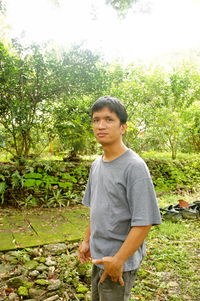
Kuya Manny
Prior to his death, Modesto Manglicmot was the main caretaker of the bonsai garden. He did the landscape design and the cultivated numerous bonsais that eventually became part of the UP Bonsai Garden. He even donated around 175 bonsais from his own private collection to the UP Bonsai Garden as part of a memorandum of agreement between himself and the University of the Philippines, signed on April 4, 2000. Aside from bonsais, the garden also exhibits other species of plants personally cultivated by Modesto Manglicmot, such as palm trees, ferns, and vines. At one point, the number of bonsais housed in the UP Bonsai Garden reached 400. They were there for the public’s appreciation. The garden was open to the public any time of the day and the entrance was free.
Modesto Manglicmot’s bonsais were really spectacular and were sought after by many collectors. Although large amounts of money, even reaching millions, were offered to purchase his bonsais, they have never been for sale. Modesto Manglicmot were attached to his bonsais and never once thought of selling them. Instead of selling his bonsais, he prefers giving them as gifts to his closest friends or donating them for fund raising event.
Nowadays, around 200 bonsais remain in the UP Bonsai Garden. Many of Modesto Manglicmot’s bonsais either died or were taken away by his wife after his death in 2012. Only a few of his award winning bonsais remain in the grounds of the UP Bonsai Garden.
History
Modesto Manglicmot’s Bonsai Garden was not initially located in the University of the Philippines. In the 1970s, his bonsais were initially displayed at his home in Project 8, Quezon City and in the greenhouse in Jose Abad Santos Memorial School (JASMS) where he used to teach. In 1985, Meralco, the electric power distributor in Metro Manila, lent him a piece of land in Marikina City under a contract. Upon the contract’s expiration in 1990, Modesto Manglicmot moved his bonsais to the Manila Seedling Bank Garden in Quezon City. His bonsais were displayed there for almost ten years until the University of the Philippines, under the administration of President Emil Q. Javier, offered him a piece of land within the campus which he could develop into his own bonsai garden. Part of the April 4, 2000 memorandum of agreement between himself and the university is his donation of almost 175 bonsais from his own personal collection to this garden, and that all the bonsais to be grown in the bonsai garden shall be property of the university. Over the years, Mr. Manglicmot was able to grow hundreds of bonsais in this garden. At one point, the number of bonsais in the garden reached 400.
To help maintain the UP Bonsai Garden, Mr. Manglicmot employed the help his nephews Rupino “Rappy” and Manuel “Manny” Manglicmot, and another caretaker named Danny.
Since the opening of the UP Bonsai Garden, Mr. Manglicmot has been offering Saturday Bonsai Classes for free to any one interested in learning how to grow and care for bonsais. The garden was also open to anyone who wants to appreciate the beauty of bonsais. Mr. Manglicmot did not charge an entrance fee. Events such as weddings, small parties, and book launches have also been held in the garden for a small fee, that it’s practically free.
On April 3, 2012, Modesto Manglicmot passed away. Since then, the management of the UP Bonsai Garden was fully transferred to the University of the Philippines. The university passed stricter rules and regulations regarding the use of the UP Bonsai Garden. Nowadays, in order to enter the garden, people must first secure an authorization from the UP Business Concessions Office. New rates have also been released for the rental of the different venues in the UP Bonsai Garden. Aside from these, the garden itself has also changed. The number of bonsais has been reduced to around 200 since some died and many were taken away by Mr. Manglicmot’s wife.[1]
Usage & Rental
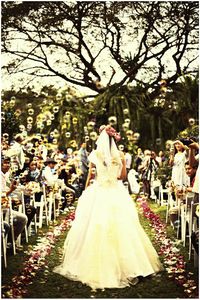
The UP Bonsai Garden can be rented for events such as book launches, weddings, debuts and other parties. The areas in the Bonsai Garden that can be rented are the following:
- Main Garden – P10,000
- Cogon Hall (small pavilion near the entrance) – P7,000
- Kakawati Hall (big pavilion) – P15,000
- Greenhouse – P15,000
The above rates are for the first 5 hours. For every succeeding hour, P1000 shall be added to the total rental fee. [2]
The following are the steps in booking the UP Bonsai Garden:
- Get a form from the UP Business Concessions Office (BCO), near College of Fine Arts.
- Fill it out and have it signed by the caretaker. (3 copies all in all – one for person renting, one for caretaker, another for the BCO).
- Pay rental about a week before the event at the cashier’s office located in the shopping center. Return receipt to the Business Office.
Bonsai Collection
As previously mentioned, the UP Bonsai Garden hosts a variety of plant species turned into bonsais, most of which are species endemic to the Philippines. The following are some of the bonsais housed in the UP Bonsai Garden:
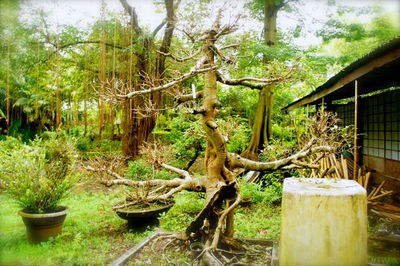
Bonsai Style: Informal upright, exposed roots
Name: Saddam
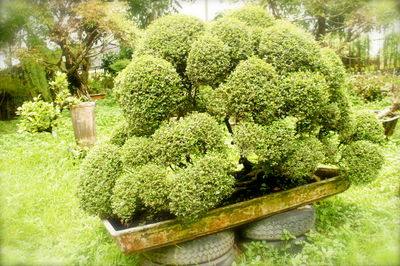
Bonsai Style: Broom
Name: Lollipop
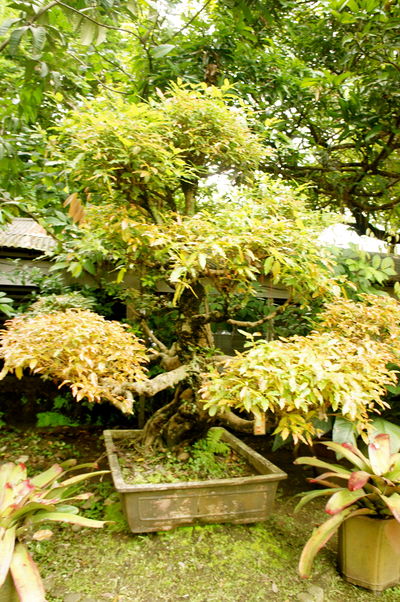
Bonsai Style: Slanted
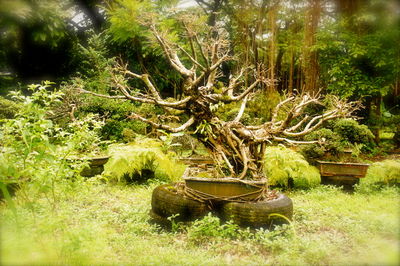
Bonsai Style: Multi-trunk, Exposed Roots
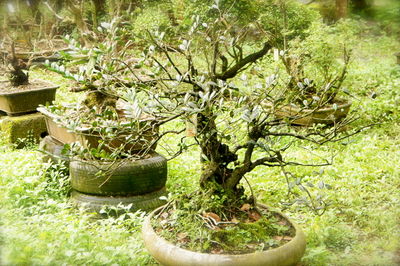
Bonsai Style: Informal Upright, Multi-Trunk
Name: Saddam
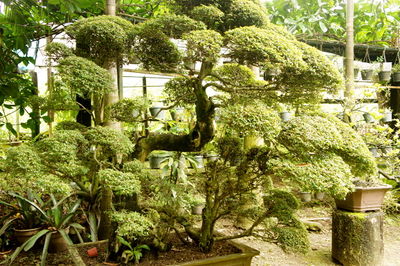
Bonsai Style: Slanted
Note: Yangya tree is also known as Aquino tree
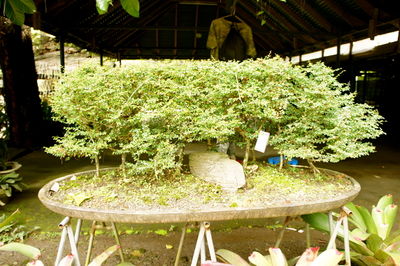
Bonsai Style: Forest
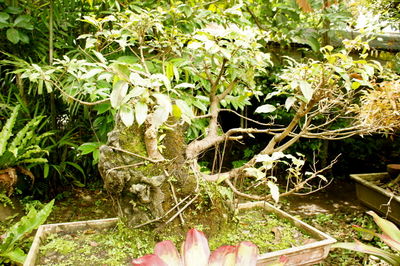
Bonsai Style: On Rock
Bonsai Garden: A Public Art
History of Bonsai
Bonsai first appeared in China over a thousand years ago on a very basic scale, known as pun-sai, where it was the practice of growing single specimen trees in pots. These early specimens displayed sparse foliage and rugged, gnarled trunks which often looked like animals, dragons and birds. There are a great number of myths and legends surrounding Chinese bonsai, and the grotesque or animal-like trunks and root formations are still highly prized today. Chinese bonsai come from the landscape of the imagination and images of fiery dragons and coiled serpents take far greater precedence over images of trees- so the two forms of this art are quite far apart.
With Japan's adoption of many cultural trademarks of China - bonsai was also taken up and introduced to Japan by means of Zen Buddhism. The exact time is debatable, although it is possible that it had arrived in AD 1195, as there appears to be a reference to it in a Japanese scroll attributed to that period. Over time, the simple trees were not just confined to the Buddhist monks and their monasteries, but also later were introduced to be representative of the aristocracy - a symbol of prestige and honour. For the Japanese, bonsai represents a fusion of strong ancient beliefs with the Eastern philosophies of the harmony between man, the soul and nature.
By the fourteenth century bonsai was indeed viewed as a highly refined art form, meaning that it must have been an established practice many years before that time.
Bonsai were brought indoors for display at special times by the 'Japanese elite' and became an important part of Japanese life by being displayed on specially designed shelves. These complex plants were no longer permanently reserved for outdoor display.
In the 17th and 18th century, the Japanese arts reached their peak and were regarded very highly. Bonsai again evolved to a much higher understanding and refinement of nature - although the containers used seemed to be slightly deeper than those used today. The main factor in maintaining bonsai was now the removal of all but the most important parts of the plant. The reduction of everything just to the essential elements and ultimate refinement was very symbolic of the Japanese philosophy of this time - shown by the very simple Japanese gardens such as those in the famous temple - Roan-ji.[3]
Principles Behind Bonsai Art
The art behind bonsai gardens is based on three principles: reduced scale, symbolizations and borrowed view.
Bonsai gardens are reduced scales of bigger objects and sceneries found in the environment, such as rivers, mountains, and forests. Bonsai gardens aim to capture nature into a confined and limited space. In the case of the UP Bonsai Garden, you will find various bonsais that mirror bigger objects, such as the forest-style bonsai mentioned previously. [4]
Symbolization works hand in hand with the principle of reduced scale. Through symbolization, small objects such as rocks are small pools of water are used to represent larger scenes or objects such as mountains and lakes. In the UP Bonsai Garden, the same can be found in many of the bonsais. Rocks are piled on top of each other to represent mountains.
Borrowed views is the manner in which bonsai gardens are able to represent bigger sceneries through smaller media. Mountains, forests, and rivers can be found within the 5000sqm lot of the UP Bonsai Garden through the different bonsais featured there. Because of this, the UP Bonsai Garden gives the illusion that it is actually bigger than what it truly is. [5]
Notes & References
- ↑ From the interview with Manuel Manglicmot. Conducted by Gail Gorospe and Eduardo Puyat. 23 September 2013.
- ↑ Rental rates as of October 2013, as stipulated by the University of the Philippines Business Concessions Office
- ↑ The History of Bonsai. The Bonsai Site. Last accessed on 22 September 2013. http://www.bonsaisite.com/history1.html.
- ↑ Bulaong, Carmen Bettina (Professor, College of Architecture). Lecture on Japanese Architecture. 17 February 2012. Virtudazo, Maricar. UP Diliman Bonsai Garden breathes new life to a fading art form. From http://www.noypi.ph/index.php/featured/5080-up-diliman-bonsai-garden-breathes-new-life-to-a-fading-art-form.html.
- ↑ Pineda, Haidee. UPD's Bonsai Garden. From http://www.upd.edu.ph/whatsup/venue.html.